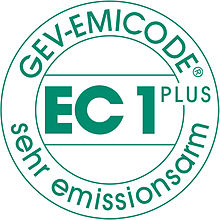Emicode
EMICODE is a trademarked environmental label for product classification for low-emission installation materials and construction products. These include fillers , joint sealants and sealants , underlays, adhesive tapes and parquet varnishes . The certification mark for environmental and indoor hygiene has been awarded by the Gev (Association of Emissions Controlled Laying Materials, Adhesives and Building Products eV) since 1997 to products from manufacturers who undergo strict quality controls and regular inspections.
From the point of view of consumer and environmental protection, EMICODE offers orientation aid for the assessment and selection of construction chemical products. The classification system is aimed at planners, consumers and craftsmen, is cross-company and non-competitive.
Test criteria
The award is based on precise test chamber tests and strict classification criteria, which are constantly updated according to the state of the art. They were developed by the GEV Technical Advisory Board together with the EUROFINS environmental institute , the Carpet Research Institute (TFI), the Association for Environmentally Friendly Carpets (GuT) and external experts. The focus is on investigating the emission behavior of so-called volatile organic compounds (VOC). These organic substance mixtures can evaporate from wall, ceiling and floor coverings at room temperature and thus get into the environment, whereby installation materials are particularly relevant. Certain volatile organic compounds can pose a risk to the human organism.
The most volatile organic compounds include solvents . When assessing indoor air quality, the amount and type of VOC emissions play a role. Concentrations of volatile organic compounds are given in mg / m³ or μg / m³, which corresponds to a thousandth or millionth of a gram per cubic meter of air.
For the EMICODE label, the product to be tested must meet a number of important basic requirements: In order to comply with one of the three categories, the total sum of the emission concentration must be within the limit values specified for the various product groups. Regardless of their classification, EMICODE-labeled products must not be formulated with any carcinogenic, mutagenic or reproductive hazardous substances . The emissions of certain carcinogenic substances are checked after 3 days in the test chamber and must be below strict limit values. An EU safety data sheet is mandatory. Products that have been licensed once are subjected to random checks - if they are violated, the EMICODE seal can be revoked. Further sanctions, up to and including exclusion from the GEV, can follow.
Three categories
EMICODE is divided into three categories, each of which allows a statement to be made about the emission behavior of the awarded product.
- EMICODE EC 1 plus, the exclusive class ("very low emissions")
- EMICODE EC 1 corresponds to "very low emissions"
- EMICODE EC 2 corresponds to "low emissions"
The classification is based on the analytically determined measurement data with regard to the total emissions in the so-called chamber test: Here, a product sample is applied to a surface in a test chamber with defined ventilation and climatic conditions. The volume of the chamber must be at least 100 liters. After 3 days and again after a total of 28 days, extensive air tests are carried out so that low-volatility substances (SVOC) are also recorded. Here come z. B. gas chromatography (GC) and mass spectrometry (MS) are used. These detect and measure even the smallest traces of volatile organic compounds in the air. The total amount of emission concentration ( engl . Total Volatile Organic Compounds ), the TVOC value is based on the EMICODE classification.
See also
Web links
- GEV website
- Floor technology 01/08
- "Blue Angel" eco-label for floor covering adhesives
- Information in the construction network
- Eurofins Product Testing
- Comparison of the Emicode seal with the Blue Angel
- Prodis website (product information system for textile floor coverings)
Individual evidence
- ↑ VOC | Volatile Organic Compounds - Background Information ; Retrieved June 27, 2013.
